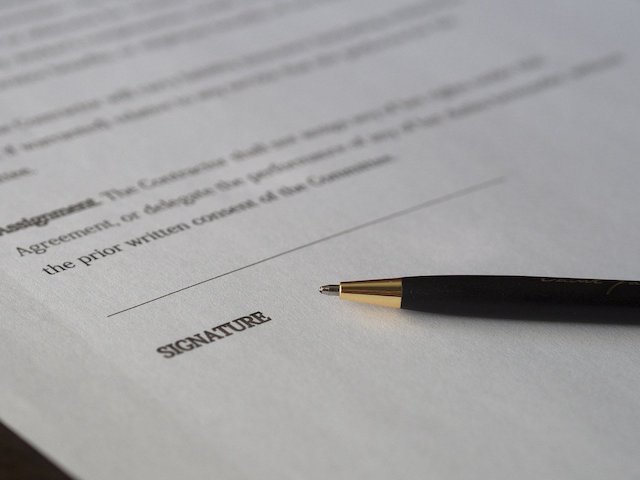Drafting a legally binding contract (and having a client agree to it) is a significant step in any freelancer’s career. It shows you’re willing to legitimize your business, protect your reputation, and safeguard your payment.
So, if you’re here to learn more about how to write a legal contract, you’re making the right call.
We know it can be tempting to stick with oral agreements and vague email promises, but that’s not how you build a real and thriving freelance business! You need security, and business contracts or a written agreement provides that.
Getting this wrong can lead to hefty lawyer fees, so making sure everything is agreed and signed correctly is a must. If you're still in doubt after this article, it's always best to seek legal advice.
First thing’s first: What is a contract?
Put simply, a contract sets out the terms and expectations of a business relationship for , ensuring that all parties involved accept and uphold their part of an agreement. A solid, legally binding freelance contract should include the following:
- An offer: You’re making an offer to your client for services rendered (like web design or copywriting). They can accept or reject this offer.
- An exchange: If accepted, in return for your services, your client will pay you money. Ka-ching!
But the truth is, there’s more to a contract than making a formal offer in exchange for cash, and across the next 12 steps, we’ll explore the key contract fundamentals you need to know.
Let's get to what you came for — 12 simple steps to writing a contract
Here's what you need to do if you're looking to create a solid freelance contract template that covers everything you need without hiring an expensive lawyer.
1. Gather as much information as possible
Before you set about drawing up a business contract, you first need to determine what it is you’re agreeing to in as much detail as possible.
- Think about every step of your service, from start to finish, listing who’s responsible for what, and when. Even if you think something might be insignificant or taken as read, write it down. Vague and ambiguous language is the enemy when it comes to how you write a contract.
- Discuss expectations, workflows, milestones and deadlines with your client to make sure you’re both on the same page. Better yet, capture this information in an email chain to give you a point of reference as you draft the contract.
2. Negotiate with the decision-maker
If you’re working with a small business, chances are you’ll be speaking directly to the business owner, which ultimately makes contract negotiation a far smoother process. You can simply set out your stall, and the owner has the final say over whether or not to proceed.
However, if you’re working with a larger organization, you need to make sure you’re dealing with the individual who has the authority to sign-off on your contract. If you end up negotiating with a junior member of staff, everything will take twice as long, as they’ll have to get the thumbs up from their boss or department head.

3. Use the right names
A simple, yet often overlooked aspect of a written contract between two parties, you need to make sure you’re addressing the right people and/or entities. This means if you’re entering into an agreement with a corporation or an LLC, you must identify them as such.
- This will make it clear who is responsible for carrying out the terms of the contract.
- It will also make it clear who you can take legal action against if the terms of the contract are broken.
4. Put everything in writing
If you have a face-to-face, video chat, or telephone call with your client, and you agree to add in an extra feature or service to your project, put it in writing.
Don’t just shake on it. Don’t let anything slip. Don’t leave anything out.
If you do end up in a dispute over payment further down the line, and you haven’t included said feature or service (along with how much it costs) in your contract, it becomes difficult, if not impossible, to enforce.
And that could leave you out of pocket. Outline everything and make sure all terms and conditions are agreed upon so there's no danger of being accused of breach of contract.

5. Writing a contract for the first time? Use a template (or Bonsai!)
The quickest way to make contracts is to use a contract template.
And the best contract templates have everything you need to include from the outset, while also offering peace of mind that they’ve been checked over by a legal professional.
Better yet, you can use Bonsai to create custom contract templates that you can use time and again. Here’s how it works:
- First, sign up for a Bonsai account. The only information you need is your name and email address.
- Once you’ve arrived at your Bonsai Dashboard, select “Create a contract”. From there you can choose an industry template or a blank contract.
- Next, fill in your project details and click “CREATE CONTRACT”.
- Bonsai guides you through a number of steps to populate the contract, including basic information about your business structure, location, and client type.
- Finally, you can describe the scope of work, add payment details, integrate your invoices, and digitally sign the contract.
Want to give Bonsai’s seamless contract creation a go? Sign up for a 7-day free trial.
6. Writing the contract — Make it simple and easy-to-understand
Writing a contract between a freelancer and a client doesn’t have to be complicated. In many cases, all you really have to do is communicate your terms and expectations, offer clarity over deadlines and payment, and cover dispute resolution and termination (more on that below). When writing graphic design contracts, let the clients know how many revisions they can get so you won't end up doing endless revisions.
This also means you should avoid complicated language or legal jargon — especially if you don’t understand it in the first place. Certain words and phrases have specific meanings under the law, so skip the legalese and opt for plain, easy-to-understand language.

7. Spell out the payment terms in excruciating detail
The primary reason for having a contract is to protect yourself and your business, and for many freelancers, this protection largely centers around payment.
When approached incorrectly, money can become a contentious issue, putting strain on a business relationship. That’s why your payment terms should be as detailed as possible.
- Clarify who’s paying whom, how much, and by when.
- If you’re asking to be paid in installments, list the amounts, dates, and acceptable payment methods.
- If you’re taking a deposit prior to beginning work, state how much and the deadline for payment.
8. Highlight and agree on dispute resolution
Another important reason for having a contract is to be able to handle disputes without risking breach of contract or the relationship breaking down.
While a contract can offer legal protection, it can also protect you from having to go to court in the first place. And this is usually beneficial to both parties, due to the time and expense involved in legal action.
So, make sure your contract states, clearly, what you and your client agree to do if something goes wrong. This might include mediation or arbitration as a last resort before you call in the lawyers for legal advice.
9. Agree on the circumstances that can lead to termination
By signing the agreement, both you and your client agree to certain roles and responsibilities in a bid to deliver the service or project in question. If one of you fails to live up to your end of the bargain, it could jeopardize the success of the agreement.
And this means that you need to explicitly agree on the circumstances that can lead to either party terminating the contract without facing any legal consequences.
For example, if your work is dependent on your client making certain resources available, and they fail to do so after a certain period of time, you should be able to walk away without violating the terms of the contract or forfeiting your deposit.
10. Keep sensitive information confidential
Working closely with a business can often mean becoming privy to important and/or sensitive information. This works both ways, as you may have certain processes, workflows, or techniques that you’ve developed over the years as a freelancer and that you wish to protect.
So, when writing a freelance business contract, you should include a confidentiality clause or non disclosure agreement which ensures that both parties agree to maintain strict confidentiality regarding any business information learned while delivering the project.
11. Determine the contract expiration date
We’re closing in on the finish line, and this step is among the most important — and most overlooked.
You need to ensure that you’re putting a timeframe or due date on your offer. If your client fails to sign and bind the contract within a reasonable amount of time, it should be void and subject to renegotiation. Otherwise, you could be agreeing to shorter lead times while delivering the same amount of work at the same budget. Don’t let this happen!
Having due dates agreed for when you can terminate the contract allows you to maintain control over your schedule and your cash flow.
12. Make it easy to sign
Last, but by no means least, you need to make your contract easy to sign and date. You can either use a wet signature or an electronic signature. Read more about what is a wet signature if you prefer the traditional way of signing documents.
Fortunately, there's a better way and this is where a contract template from Bonsai comes into its own. Instead of asking your client to print, sign, scan and return, they can simply add a legally binding online signature, speeding up the process and allowing you to get to work faster. In case you used Microsoft Word to create the contract, we've also prepared a guide on how to insert a signature in Word. Adobe Acrobat is also one of the tools that you can use to digitally sign a document. You can read our guide on how to create a digital signature in Adobe if you want to learn more. Finally, always remember to shift the terms of the contract over to your letter of engagement which will spell out the terms of how you do business.

Still not 100% sure? Let’s recap
When it comes to contracts, the devil is in the detail. From the moment you sit down to write a freelance agreement, it’s up to you to leave no stone unturned.
- Make sure you have everything in writing, with a clear project scope, and addressed to the right person, people, or organization.
- Use plain language, avoid legal jargon, and be clear with your payment terms.
- And finally, make it easy for each party involved to sign and date.
Looking for a contract template? Bonsai has your back. Create and sign from vetted templates, streamlining your project and giving you peace of mind that your business is protected.
Sign up for a no-risk 7-day free trial today.

.webp)




